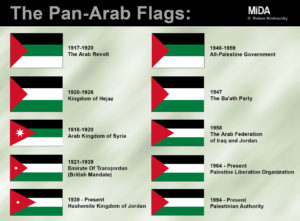Opponents of Israel, including many of its Arab citizens, defiantly wave the PLO flag, yet have no idea what it actually symbolizes and that it has served many other Arab causes. The origins and history of a false flag.
Dozens of the Arab demonstrators protested on Saturday in Tel Aviv, chanting against the State of Israel with the cries of “With spirit, with blood, we shall redeem thee Oh Philistin”, as they defiantly waved the PLO flag. Ironically, history shows that this flag had no connection to the British Mandate area called “Palestine” nor to the Arab population referred to today as “Palestinians”.
A major symbol of the fight against the very existence of the State of Israel, this flag was adopted by the Palestinian Authority (PA) as its banner in 1994. In fact, when the PLO made this their flag in 1964, they adopted what was known then as the Pan-Arab flag, a flag that changed ownership several times over its nearly a century of existence. It is still being used by different groups, in different countries and under different circumstances.
The British Empire, entrusted with a mandate over “Palestine”, by the League Of Nations (1922), used a flag of their own, which features the Union Jack symbol at the top-left corner and a white circle with the word “Palestine” inside, over a red or blue background.

Another version of a “Palestine” flag is found in the French flag lexicon “Nouveau Petit Larousse” in the 1920’s-30’s: half white, half blue background with a yellow Star of David in the middle.

So where did this flag, now recognized worldwide as the “Palestinian” flag, actually come from? Who originally made it and for what purpose? What do the colors of the flag represent? What does all this say about the Arab connection to the Land of Israel?
The story of this flag actually starts with the Arab Revolt in the Arabian peninsula between the years 1916-1918. The region was under the control of the Ottoman Empire, and the rule of Sultan Abdul Hamid the second. The flag was designed in 1916 by Mark Sykes, a British Lt. Colonel and leading adviser for Middle East affairs, who would later devise the Middle East as we know it under the Sykes-Picot Agreement.

The Arab Revolt flag in its primary form was in use for only three years, between 1917-1920, by Hussein ibn Ali al-Hashimi, a Hashemite Arab leader who was the Sharif and Emir of Mecca from 1908. This flag features three horizontal stripes, black at the top, green at the middle and white and the bottom, and red triangle at the left. The colors symbolize the 4 great caliphates of Islam and were to appear in many forthcoming Arab flags.

After the First World War, a new version of this flag was presented for the Kingdom of Hejaz, between 1920-1926. Another version of this flag with an additional 7 pointed star, which marks the “Fatiha” (first 7 lines of the Qur’an) was chosen to represent the Hashemite Kingdom Of Jordan.
The Colors of the Pan Arab Flag and What They Signify
While it was Mark Sykes who was responsible for the flag’s design, the decision behind the selection of colors is disputed. One version gives the full credit to Sykes himself. Another version claims these colors were selected by the Arab nationalist ‘Literature Club’ in Istanbul in 1909.

They created a banner for their council with the four colors as described in the words of a thirteenth century poem by Safi a-Din al-Hili, of Hilla Iraq:
Ask the high rising spears, of our aspirations
Bring witness the swords, did we lose hope
We are a band, honor halts our souls
Of beginning with harm, those who won’t harm us
White are our deeds, black are our battles,
Green are our fields, red are our swords.
A third version gives credit to the “Society of Young Arabs”, which was formed in Beirut in 1914.

The four Pan-Arab colors featured in most Arab flags represent the great Islamic rulers – the Caliphates and their dynasties. These continuously warred among themselves while expanding in conquest the boundaries of the Arabian peninsula empire. They colonized vast areas, from current day Iran and India, through north Africa all the way to the Iberian Peninsula (Al-Andalus), into the Muslim world.
Red marks the Hashemite people. They ruled the Hejaz continuously for centuries and the city of Mecca between 1201 and 1925. Their symbol was a red flag, which became the symbol of the Islamic rulers of Andalusia in the years 756-1355;
Black marks the Abbasid caliphate. They ruled from Baghdad and used the black flag as a symbol of mourning for the assassination of the Prophet Mohammad’s relatives and a remembrance for the Battle of Karbala;
White marks the Umayyad caliphate, who’s white flags were used as a reminder of the Prophet’s first battle at Badr. Mu’awia Ibn Abi Sufian the first, founder of the Umayyad state, proclaimed himself Caliph of Jerusalem and was crowned as the caliphate of the Islamic empire. As a ruler, Sufian moved the center of Islam from Mecca to Damascus;
Green marks the Fatimid caliphate, a Shi’ite caliphate founded in Morocco named for the the daughter of Mohammed, considered holy to the Shi’ite Muslims. They ruled over all of North Africa, the Hejaz and Yemen, the Land of Israel, Syria and Sicily, in the years 909-1171. They chose the color green, to symbolize their allegiance to Ali, Mohammed’s cousin, who had wrapped himself in a green quilt to take the place of Mohammad, in order to thwart an assassination attempt.

The Arab Revolt
The origins of the Great Arab Revolt date back to 1908 and the growing discrimination of none-Ottoman citizens in the empire, that continued with executions of Arabs citizens by the Ottomans with the beginning of WWI in 1914. The Arab population was concerned with the completion of the Hejazi railway, which would allow the Ottomans to transfer their forces, weaponry, ammo and equipment more efficiently and quickly.

Sultan Abdul Hamid the second, used his authority as a religious caliphate to call on Muslims all over the world to join him in a sacred war (Jihad) against his enemies. His enemies included the British and French governments and their colonial regions. Since there were over 100 million Muslim citizens under the British Empire, the British themselves were targeted by the Sultan.
In an attempt to pacify them, the British government agreed to establish a large Arab kingdom under the Hashemite Sharif of the Hejaz region, Hussein ibn Ali al-Hashimi, in the Arab Peninsula and the regions of Iraq, Syria, Lebanon and Israel (or “Palestine” as they called it). Hussein envisioned the establishment of a united Arab empire under his rule.

In June 1916 the military forces of Hussein started attacking small Ottoman forces. However, this revolt failed soon after. Hussein didn’t become the great Arab leader of his Arab Empire, as he didn’t manage to garner massive support from the Arab world he wished for. Apart from some local Bedouin tribes of the Hejaz region who were loyal to him, others didn’t see themselves as part of the Hashemite people and obligated to his goals. The Arab Revolt actions did score some success with the conquest of few towns around the Hejaz and Aqaba, but they failed to conquer the holy city of Medinah, that was under the Ottoman’s rule.

By the end of the first World-War and the establishment of new states and mandates in the Middle East, the two sons of Sharif Hussein, Abdallah and Faisal were appointed as monarchs of the Arab kingdoms of Syria, Trans-Jordan and Iraq; as a reward for Hussein’s assistance to the British in the war. Soon after though, The Arab Kingdom of Syria was taken over by France and as compensation, the British appointed Faisal to be the king of Iraq.
How the Pan Arab Flag Became the Flag of Arab “Palestine”
The flag of the Arab Revolt was adopted by the “Arab Kingdom Of Syria” in 1920, with an additional “Fatiha” star over the red triangle.

The Kingdom of The Hejaz also used the Pan-Arab flag, in which the location of the green and white stripes was swapped. The Kingdom Of Hejaz lasted until December 1925. They surrendered to the forces of Abdul Aziz, who thereafter proclaimed himself King of Hejaz, in January 1926 and merged his dominions into “The Kingdom of Hejaz and Nejd“. It lasted for 6 years, until the establishment of Saudi-Arabia in 1932.
Aziz used for his kingdom an Arab-Revolt flag, but replaced the white strip that marks the Umayyad dynasty with a yellow stripe. The yellow represents the Ayubbid dynasty (12-13 centuries) and Ayub’s grand-son – Saladin (Salah A-Din).


The “All Palestine Government”
After 1926, the original Pan-Arab flag was abandoned, but not for long. 20 years later it was picked up and used again, by several new political entities, who were trying to promote the concept of Arabic unity in the Middle East. The Pan-Arab flag has been slightly changed in its scale in some versions, but basically the flag remained as it was.
In September 22, 1948 the Arab League established in Gaza (that was under Egypt’s control) a political entity which they called “All-Palestine Government”. This was an attempt to establish an independent Arab state of “Palestine”, on the exact region were the modern Jewish state was established. They picked as their flag the flag of the Arab Revolt, that wasn’t in use for many years. However, this political entity left no real mark and was disbanded by the Egyptian government in 1959, because it served no real purpose.
“The Arab Federation of Iraq and Jordan”
Also called “The Arab Union” and “The United Hashemite Kingdom of Jordan and Iraq”. It was a short term political union between Hashemite kingdoms, who used a wider version of the Pan-Arab flag, with a bigger triangle. Their kings, Faisal the first (Iraq) and Abdallah the First (Jordan) were brothers, sons of the Sharif Hussein Ibn-Ali who formed this federation, as a response to the union between Syria and Egypt, known as the “United Arab Republic” (1958-1961). It’s leader, Jamaal Abd Al-Nasser, called for a dissolution of Arab monarchies (like Jordan and Iraq). He strove for Arabic unity under his rule, objected to western culture and supported socialism and communism. While the Arab Federation of Iraq and Jordan came as an alternative to “Nasserism”, it lasted only 6 months, due to the military coup in Iraq in July 1958.

The Ba’ath Party
The Pan-Arab Flag had already been in use by another group who held exact opposite values to the Arab Federation. The “The Arab Socialist Ba’ath Party” (حزب البعث العربي الاشتراكي ) was founded on 7 April 1947, by Michel Aflak and Salah al-Din al-Bitar. Their major goal was to defeat western colonialism, while working as secular, Pan-Arab nationalist and socialist party. Their motto: “Unity, Liberty, Socialism” – while Unity refers to unity of the Arab world; Liberty refers to liberty from a foreign or western influence, Islam and the tribal culture, that are obstacles to Arabic progression; and Socialism, which refers to a new Arab-social perspective which contradicts Marxism. In addition to that, Anti-Zionism was also one of their major agendas.
The Ba’ath party gained most of its support in Syria and Iraq, and also had branches in other less dominant countries, such as Lebanon, Libya and Jordan. Their activity and values were absorbed in a new movement in the 60’s – the PLO.

Palestine Liberation Organization
The PLO was initiated by Arab states, with additional involvement and encouragement by the Soviet Union and was established in June 2nd 1964. It came as an alternative to the failed “All Palestine Government”, in order to consolidate the political activity of the Arab world against the young state of Israel. The PLO adopted most of the Ba’ath Party’s values and also their flag – the Pan-Arab flag.
With that, the PLO cultivated the concept of Arabs as the real “Palestinians”, whose fate is intertwined with the rest of the Pan-Arab Nationality.
The PLO logo, its organizations and parties all use the Pan-Arab flag in its wider version. Their logos feature repetitive and common elements: the Pan-Arab flag and a figure of Israel’s map (without the Green Line in Judea and Samaria). Some logos combine a scheme of “The Dome of the Rock” building on the Temple Mount in Jerusalem and weapons to mark their war against “The Zionist Occupation”.
With the Oslo accords being signed in 13 September 1993, the Pan-Arab flag was adopted to represent the Palestinian Authority and is now recognized by the international community. However, at this stage the PLO had to deal with an external and separate organization, which has been forming in Gaza in the late 80’s – Hamas.
The Pan-Arab flag in effect symbolizes the real story behind the Middle East of the past century. It illustrates the failure of the Muslim Arab-world effort to unify and become one united nation, a desire they are pursuing since the dawn of Islam. All attempts to unite the divided and conflicted Arab-world failed. Arab states constantly engage in tribal and religious wars and are in various stages of disintegration.
It made no difference whether it was Sharif Hussein and his sons, the Ottomans, the British or French, efforts of Egypt or the Ba’ath party. None of them succeeded in unifying the Arab world for an extended period. Even the hatred for Israel and creation of a “Palestinian” Arab People myth to undermine the legitimacy of the Jewish claim to a nation state is losing its appeal.
This flag nowadays represents a divided political entity, one who’s true motives are not national, but basically religious and anti-Semitic.
All of which unfortunately, does not stop the international community from recognizing the Pan-Arab flag as a symbol for a fictitious Arab people of a country that has never been established and doesn’t have any social or political chance of being created and thriving.
Israel opponents and detractors all over the world wave this flag without knowing a thing about it; what it symbolizes, what it was originally made for and by who.
____________________
Rotem Ninkovsky is the media consultant for the Kedem Forum For Israel’s Public Diplomacy and Middle East Studies
[To receive updates on more in depth articles on Israel and the Middle East, join us on Facebook or Twitter ]






I am very happy to have discovered you.
Thank you.
Very important and informative article.
This should be published in the main-stram media, instead of saying ‘palestinian flag’ over and over.
Thank you.
Yes, I’m well aware to the “Palestinian Flag” term and “Jordan flag without the star” etc.
That’s why I made this research to make this un-accessible information available and organized. Had to go through lot of dis-information and partial data, until I found the correct and almost full story.